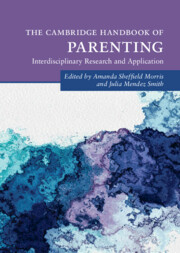Book contents
- The Cambridge Handbook of Parenting
- Cambridge Handbooks in Psychology
- The Cambridge Handbook of Parenting
- Copyright page
- Dedication
- Contents
- Contributors
- Figures
- Tables
- Introduction
- Part I Foundations of Parenting
- Part II Parenting across Development: Social, Emotional, and Cognitive Influences
- 8 Bolstering the Bond: Policies and Programs That Support Prenatal Bonding and the Transition to Parenting
- 9 Parenting during Infancy and Early Childhood
- 10 Parenting That Promotes Positive Social, Emotional and Behavioral Development in Middle Childhood
- 11 Parenting Adolescents
- 12 Parenting during Emerging Adulthood
- Part III Parental Factors That Impact Parenting
- Part IV Child Factors that Impact Parenting
- Part V Parent Education, Intervention and Policy
- Index
- References
9 - Parenting during Infancy and Early Childhood
from Part II - Parenting across Development: Social, Emotional, and Cognitive Influences
Published online by Cambridge University Press: 01 December 2022
- The Cambridge Handbook of Parenting
- Cambridge Handbooks in Psychology
- The Cambridge Handbook of Parenting
- Copyright page
- Dedication
- Contents
- Contributors
- Figures
- Tables
- Introduction
- Part I Foundations of Parenting
- Part II Parenting across Development: Social, Emotional, and Cognitive Influences
- 8 Bolstering the Bond: Policies and Programs That Support Prenatal Bonding and the Transition to Parenting
- 9 Parenting during Infancy and Early Childhood
- 10 Parenting That Promotes Positive Social, Emotional and Behavioral Development in Middle Childhood
- 11 Parenting Adolescents
- 12 Parenting during Emerging Adulthood
- Part III Parental Factors That Impact Parenting
- Part IV Child Factors that Impact Parenting
- Part V Parent Education, Intervention and Policy
- Index
- References
Summary
In this chapter we focus specifically on parenting from birth to age 5, a period marked by rapid development for the child and widely believed to set the foundation and quality of the emerging parent-child relationship. We begin with an overview of key developmental milestones, stages and transitions that influence the emergence and evolution of parenting over the period from birth to age 5. Then we review relations between five dimensions of parenting (sensitivity and parent child attachment, socialization, cognitive stimulation, discipline, and maltreatment) and relevant child outcomes, attending to child characteristics that moderate these associations. Next, we described parental characteristics and experiences that predict parenting behavior and child outcomes. These include: normative parental beliefs and emotions; acculturation processes and discrimination; childhood experiences; adult stress and trauma; and psychopathology. Throughout our review, we attend to the roles of race, ethnicity, and culture. This is followed by consideration of the value of this work for policy, prevention, and intervention efforts. In the summary, we draw attention to recent advances in this line of inquiry along with remaining limitations. We conclude by emphasizing our primary thesis: parenting in infancy and early childhood is a key factor that can enhance or undermine children’s concurrent and long-term wellbeing and achievement depending on the quality and context in which it occurs.
- Type
- Chapter
- Information
- The Cambridge Handbook of Parenting , pp. 191 - 212Publisher: Cambridge University PressPrint publication year: 2022



